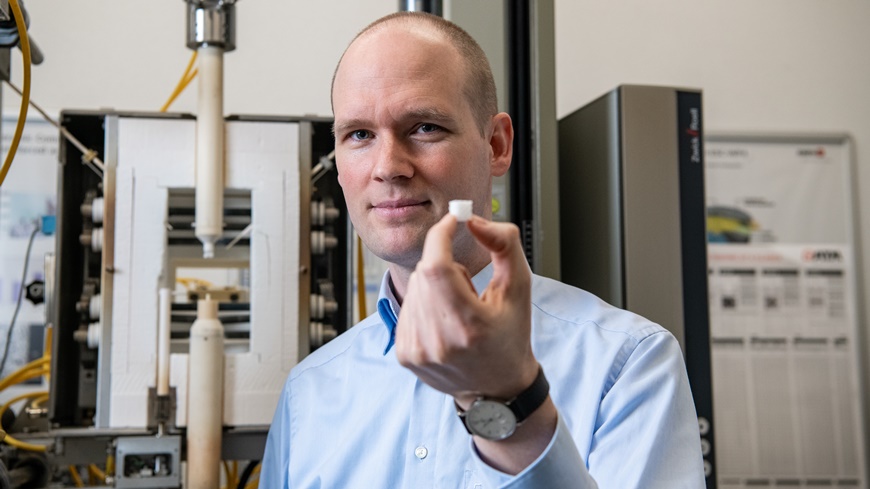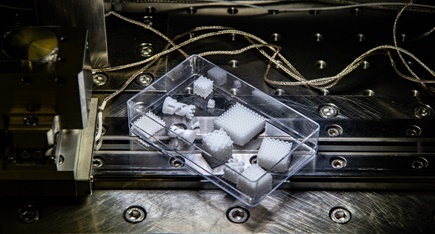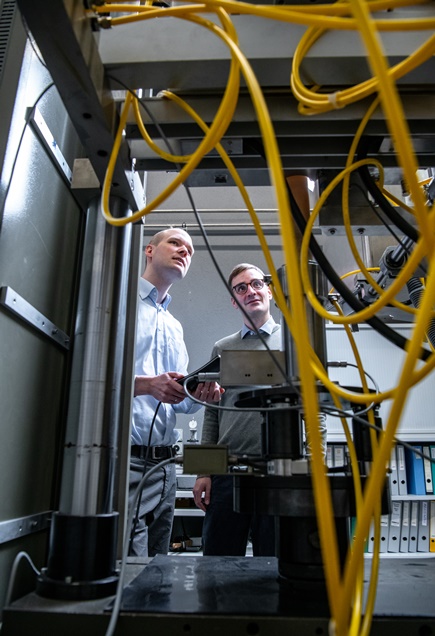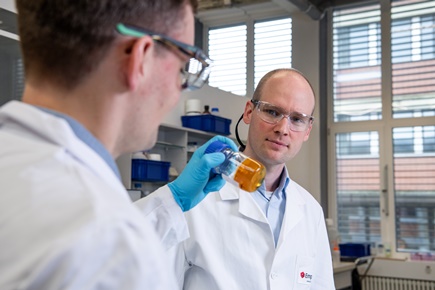New head of Empa's laboratory for High-Performance Ceramics: Jakob Schwiedrzik
A materials' architect
Engineer, mechanics expert, bone researcher, materials scientist: Jakob Schwiedrzik has a multifaceted research profile. For several months now, he has been at the helm of Empa's Laboratory for High-Performance Ceramics. With his interdisciplinary expertise, his thirst for knowledge and his drive for action, he wants to help both his laboratory and ceramics as a material to reach new heights.

Faced with the obligatory question about the correct pronunciation of his name, Jakob Schwiedrzik responds with equanimity. “Schwirzik” is close, he says. "The first syllable comes from German, the second from Polish. As a result, neither the Germans nor the Poles can pronounce it correctly," laughs the tall scientist.
Much like his name, Schwiedrzik himself moves between different fields: materials science, engineering, mechanics, medicine, mathematics. Since August 2024, the scientist has been leading Empa's Laboratory for High-Performance Ceramics. He joined Empa ten years earlier, first as a postdoctoral researcher and later as a group leader in the Laboratory for Materials and Nanomechanics in Thun, where he conducted research into thin film and small scale mechanics. One of the focal points of his research activities during this time was a special material: bone.
Ceramic in our bodies

From bone to ceramics – a long leap? Less than you might think, says the 39-year-old. "Bones are a composite material. They consist of a biopolymer, collagen, and a mineral component, hydroxyapatite, a bioceramic." Many ceramics are therefore considered promising materials for biomedical applications, such as implants. Other specialty ceramics promise breakthroughs in lightweight construction, chemical catalysis, energy storage and CO2 capture from the atmosphere. “Ceramics are great: light and stiff, chemically resistant and biocompatible, temperature-resistant and with interesting catalytic properties,” Schwiedrzik lists. The weakness of the “super material” lies in its mechanical properties: Ceramic is brittle and prone to fracture.
But in this weakness, Schwiedrzik sees great potential for innovation. The materials scientist in him knows that the composition of a material is only half the story. Its structure is just as important. “If you structure ceramics correctly in the micro- or even nanometer range, they can become ductile and behave almost like a metal,” he says. This is still a vision of the future – but not an unattainable one, the newly appointed lab head is convinced. He and his Architectured Materials research group at Empa in Thun have investigated and developed precisely such microstructured materials.
This expertise is now at the full disposal of the Laboratory for High-Performance Ceramics – a good addition, says Schwiedrzik. "The development of new materials has three components: manufacturing process, structure and functional properties," explains the researcher. "Thanks to my predecessor Thomas Graule, our laboratory is very strong in the area of process development and 3D printing of technical ceramics. Now we can complement this focus with my expertise in researching the relationships between structure and mechanical properties in particular. We combine simulation and experimental approaches to do this." The laboratory is gaining a broader portfolio with its new head. At the same time, Schwiedrzik is also broadening his horizons. “Interdisciplinarity has always motivated me,” he says.
The courage to explore

A glance at his CV confirms this. Schwiedrzik originally studied mechanical engineering at the Vienna University of Technology. “As a teenager, I was enthusiastic about science and technology, especially aviation,” he says. “Studying mechanical engineering seemed to me like becoming a jack-of-all-trades: It offered a broad overview of a great many topics.”
His plan worked. In addition to thermodynamics and fluid dynamics, mechanics, materials science, electrical engineering and computer science, the inquisitive student discovered a lecture on tissue biomechanics during his Master's degree. “That was the most difficult lecture I've ever had in my life,” laughs Schwiedrzik. "Not only did I have to understand the anatomy of all tissues, but I also had to describe them mathematically. It felt like there was enough material for two years in just one semester." Where most of his fellow students gave up, he accepted the challenge. "It was very demanding, but also very interesting. I was often the only student who finished the exercises. As a result, I also had one-to-one discussions with the professor," he recalls.
This tenacity became Schwiedrzik's stepping stone to an academic career; the professor, Philippe Zysset, became his doctoral supervisor. He completed his doctorate in the field of bone biomechanics. When Zysset moved from TU Wien to the University of Bern in 2011, the young doctoral student followed him to Switzerland. Shortly afterwards, he met Johann Michler, head of the Mechanics of Materials and Nanostructures Laboratory at Empa in Thun, at a conference. The two researchers began an interdisciplinary collaboration. After completing his doctorate, Schwiedrzik joined Michler's team and entered the world of materials science. A common thread in his life as a researcher: “Every step in my career was also a jump in at the deep end,” he smiles.
Fortunately, he finds such jumps refreshing – both in research and also literally, in the swimming pool, which he enjoys visiting with his two children, aged seven and nine. “For me, family time is the best way to balance out my job,” says Schwiedrzik. Balance is needed, because the demands on a lab head are many and varied. “I have to consciously schedule time to think instead of just rushing from one meeting to the next,” says Schwiedrzik.
Bridges to success

Schwiedrzik faces his new administrative tasks with the same curiosity and motivation as the new research topics. He has already taken on additional roles at Empa Thun, such as the vocational training of physics laboratory technicians and leading the local first-aid team.
At heart, however, Schwiedrzik remains a researcher. He is continuing to lead his own research group Architectured Materials, now as part of the ceramics laboratory. “We are also strengthening the collaboration between the Empa sites in Dübendorf and Thun, which I am very pleased about,” says the laboratory head. He sees the uncomplicated cooperation between the different laboratories and research areas – the team spirit – as one of Empa's greatest strengths. The other is its bridging function between research and industry. “We conduct excellent basic research that is also applications-oriented – and we aim to implement it with our partners from industry,” says Schwiedrzik.
Ceramics especially is drawing great interest from industry, in particular in the fields of environmental technology, energy and medicine. “The climate crisis, the energy transition and an ageing society are important societal challenges to which we can make a direct contribution,” emphasizes the laboratory head. Despite the multitude of problems that our society is currently facing, Schwiedrzik is optimistic about the future: “A challenge is always an opportunity to grow and to develop.”
Vita
Jakob Schwiedrzik (*1986) leads the Laboratory for High-Performance Ceramics at Empa in Dübendorf since 1 August 2024. He studied mechanical engineering at the Vienna University of Technology and then completed his doctorate at the University of Bern in the field of bone micromechanics. He completed his doctorate in 2014 summa cum laude. Schwiedrzik came to Empa as a postdoc in the Laboratory for Mechanics of Materials and Nanostructures in Thun , was promoted to scientist in 2017 and won an Ambizione Grant from the Swiss National Science Foundation (SNSF) in the same year. In 2021, he became group leader for Architectured Materials, also at the Laboratory for Mechanics of Materials and Nanostructures. In addition to his scientific work at Empa, he is also a lecturer at ETH Zurich, EPFL and the University of Bern.
-
Share






